Every eleven minutes, someone in the United States dies from an opioid overdose. That’s a harsh, impossible-to-ignore reality. Yet, most of us scroll right past headlines about fentanyl busts, or tune out when the news mentions ‘the opioid epidemic’. We think, ‘That can’t happen to me, or my family.’ The scary truth? Nobody is immune. Opioids are sneaky—they wear many faces, from prescription painkillers to heroin to synthetic drugs you’d never expect.
But here’s the twist: knowledge and openness can break their grip. When people understand what opioids do, how addiction works, and where to get solid help, it changes the story. We’ve seen it before with tobacco and drunk driving—education didn’t fix everything overnight, but it made a real dent. Maybe it’s time we did the same for opioids, starting with honest talk that’s free of shame and loaded with facts.
Why Understanding Opioid Addiction Matters
Opioid addiction isn’t just about willpower. The drugs hijack the brain’s reward center, making quitting incredibly tough, even for the most determined person. It all starts so innocently: someone has a surgery, gets a painkiller, and suddenly the fuzzy line between treatment and dependence blurs. According to the CDC, more than 2.5 million Americans battle opioid use disorder right now. And for a shocking number, the gateway was a prescription written for a sports injury or a dental procedure.
So why do so many folks miss the early warning signs? It happens because opioids don’t look dangerous at first. They’re legal, often come in a pharmacy bottle with your name, and doctors hand them out thinking they’re helping. Only after repeated use—or a moment of experimentation—does dependency creep in. People often don’t even realize it’s happening until the cravings kick in hard and the meds run out. By then, willpower alone isn’t enough. The brain’s chemistry literally changes, needing more opioid stimulation to feel normal.
And here’s something nobody likes to talk about: opioid addiction strikes everywhere. Urban, rural, rich, poor, cool kids and shy kids. Mom next door. Your cousin’s best friend. People hide it because they’re ashamed or scared of judgment, which only makes things worse. When we leave opioid addiction in the shadows, it wins.
On top of that, there’s a web of risk factors. Genetics matter. Family history matters. But so do stress, trauma, access to healthcare, loneliness, and how often you see doctors playing it fast and loose with the prescription pad. Preventing addiction isn’t about blaming individuals. It’s about making sure everyone gets the facts in their language, when and where it counts.
Dispelling Myths: What We Get Wrong About Opioid Addiction
Let’s clear something up: opioid addiction is not a moral failure or just a bad habit. Yet stigma is everywhere. Tons of people, even some in healthcare, secretly believe that addiction is just about weakness or bad choices. This belief stops people from reaching out, and it makes families hide what’s happening. According to a 2023 study from Johns Hopkins, nearly half of Americans would be uncomfortable if a friend had a prescription opioid problem—showing how stigma lingers even as science says otherwise.
Second, there’s the myth that prescription painkillers are always safe if your doctor says so. In reality, even following instructions to the letter can lead to trouble if your body is prone to addiction. It’s not about ‘bad’ people; it’s about bad information—period.
Then there’s the stereotype that opioid addiction only happens with illegal drugs. Not true. About 80% of heroin users started out misusing prescription opioids. People think ‘that’s not me’ because they’re taking medicine from their own bottle. But the transition from pills to street drugs, or to stronger substances like fentanyl, can be quick and devastating. Fentanyl is 50 to 100 times more potent than morphine, and just two milligrams (about the size of a few grains of salt) can be fatal. Dealers mix fentanyl into heroin, cocaine, and even fake pills, which means people end up taking it without even knowing.
Kids and teens aren’t immune, either. In the last few years, schools have reported more overdoses linked to ‘prescription’ pills that turn out to be laced with fentanyl or other synthetics. Most parents don’t realize that just because pills come in a familiar shape or color, doesn’t mean they’re safe or from a legitimate source.
Busting these myths takes effort, but once you see through the fog, it’s easier to spot danger and support those who need it.

The Power of Education in Prevention
So, how do we keep people from falling into the opioid trap? Real, no-fluff education is a good place to start. Researchers from Stanford showed that communities with strong public education campaigns about opioids saw a drop in prescription drug misuse and more families asking about alternatives for pain management. When you know the risks—really know them—you make different choices.
The best programs skip the scare tactics. They give the facts, show what opioids do to your brain, and offer smarter ways to deal with pain or stress. Some schools bring in people who’ve survived addiction to tell their stories. For example, the Recovery Speakers program invites everyday folks who’ve walked this road to talk with teens, families, even doctors. Students say those talks hit harder than any textbook lecture because they’re real.
Parents play a huge role, too. Honest conversations at home about drugs—without eye-rolling, lectures, or drama—work better than pure discipline or avoidance. The Partnership to End Addiction recommends starting these chats early and keeping them short and matter-of-fact. Simple, regular talks about pills found in medicine cabinets, or what to do if a friend offers something at a party, make a huge difference.
| Group | Opioid Overdose Rate (per 100,000) | Years (USA) |
|---|---|---|
| Teens (15-19) | 6.0 | 2023 |
| Adults (25-44) | 39.1 | 2023 |
| Seniors (65+) | 11.5 | 2023 |
There’s help for teachers, too. Programs like Prescription Drug Safety from EVERFI give schools ready-to-go lessons that cover safe use, storage, and disposal, so that kids get practical skills instead of just fear.
And let’s not forget about doctors and pharmacists. The CDC’s recent guidelines push for shorter opioid prescriptions and encourage doctors to try physical therapy, over-the-counter pain relief, and other alternatives first. Some hospitals now require extra training for anyone who prescribes opioids. It sounds simple, but even just asking your doctor, “Is there a non-opioid option?” can push the whole system toward safer practices.
Bottom line: education works best when it’s not a ‘one and done’ deal. It needs to happen everywhere—schools, homes, clinics, and online. The more places you reinforce the message, the more likely people are to remember it when it counts.
Awareness in Action: Spotting And Responding to Warning Signs
Knowing what opioid addiction looks like (before it gets out of control) is huge. The ‘classic’ signs—like drowsiness, pinpoint pupils, or constant flu-like symptoms—aren’t always obvious, especially in the early stages. Other red flags sneak up: missing pills, secretive behavior, sudden money troubles, and a loss of interest in things that used to matter. Friends and family often notice the change before the person does, but aren’t sure what to do about it.
One concrete step is to keep a mental checklist. If someone you know is using more painkillers than prescribed, running out early, or ‘doctor shopping’ for extra refills, that’s a loud warning bell. So is finding pill bottles without labels or seeing white powder residue in odd places.
Tech has a role to play, too. Smartphone apps like Tremedda or Sober Grid now let people track their habits, reach out for help in a crisis, and even connect with peer support 24/7. For families, free training sessions teach how to use naloxone, a medication that reverses opioid overdoses. In most states, you can get naloxone from a pharmacy without a prescription—and carrying it can literally save lives. According to CDC stats, bystander naloxone use increased survival rates by nearly 85% in overdose situations.
Schools and community centers are stepping up as well. Many have installed accessible naloxone kits alongside defibrillators, run seminars where anyone can come learn about recognizing signs of addiction, and offer support not just to users, but to their families. At work, some businesses run wellness days with booths for addiction education or mental health support—it’s becoming more common, especially in industries hit hard by opioid misuse, like construction or food service.
Nobody should have to figure out opioid warnings alone. Using online resources—like the Substance Abuse and Mental Health Services Administration (SAMHSA) helplines, or dedicated crisis text lines—means help is always just a click away. And for those who’ve lost someone or who are deep in the struggle, finding non-judgmental support can be the difference between hope and despair.
- Watch for sudden behavioral changes
- Don’t ignore missing medication
- Train family members in naloxone use
- Encourage open talk about pain and stress
- Use digital tools to find trusted info and support
Staying aware isn’t just about crisis moments. It’s about normalizing conversations and refusing to let shame win.

Long-Term Solutions: Building a Culture of Prevention
The opioid crisis didn’t happen overnight, and it won’t end with one PSA or school assembly. Creating real change takes commitment from every direction. Communities that treat addiction as a health issue—not just a crime—see better recovery rates and fewer deaths. Portugal took this approach years ago, and their overdose deaths dropped by over 80% after shifting from punishment to treatment and education. That kind of culture shift starts with the stories we tell, the way doctors prescribe, the tools we give families, and the honest talk in our homes.
Here are a few ways you can help—whether you’re a parent, teacher, coach, boss, or just someone who cares:
- Ask about pain relief alternatives during any doctor visit.
- Clean out your medicine cabinet regularly and dispose of unused opioids safely (pharmacies often have drop-off boxes).
- Teach kids to check with an adult before taking any pill, even one from a ‘friend.’
- Support local and national programs that raise opioid awareness—attend a training session or share what you learn with friends.
- Promote kindness, not judgment, when someone is struggling—showing you care really does make it safer for them to ask for help.
Policy changes matter, too. The CDC, FDA, and local governments are working on better prescription monitoring, limits on pill quantities, and expanding access to care for those already hooked. In 2025, Medicare and many insurers now cover a wider range of addiction treatments, making it a bit easier to find professional help.
It’s not about being perfect. It’s about being ready, being honest, and refusing to let silence do more harm. We’ve already seen glimmers of hope where people team up, share knowledge, and build real solutions brick by brick. The fight against opioid addiction is tough—but with education and true awareness leading the charge, it’s a fight people are finally starting to win.

Opioids don’t care if you’re rich or poor. They just show up, quietly, and take over. I’ve seen it happen to two people I know-one from a knee surgery, another from a tooth extraction. No warning. No drama. Just... gone.
The neuropharmacology here is critical-mu-opioid receptor upregulation leads to tolerance, then dependence. But stigma prevents translational public health adoption. We need policy-integrated education, not just awareness campaigns.
Bro. I saw my cousin OD on fake oxycodone. 😢 He thought it was from his buddy’s medicine cabinet. Fentanyl is a ghost. We gotta talk. Now.
So many people think it’s a ‘choice’... but it’s not. It’s a brain disease. And if you don’t understand that, you’re part of the problem. Please, just listen.
Of course the government lets this happen. Big Pharma paid off the FDA. They want you addicted so they can sell you naloxone later. It’s all a scam. Wake up.
You think education fixes this? LOL. The real fix is locking up dealers and cutting off prescriptions entirely. You don’t ‘talk’ someone out of addiction-you take away the supply and make them suffer through withdrawal. That’s how you scare them straight.
Oh wow, another ‘education saves lives’ piece. Did you also include a chart showing how many people died after watching a YouTube video? Real helpful. Meanwhile, pharmacies still sell 100 pills like candy.
Hey everyone-this is real. I’m in recovery now. I started with a prescription after a car accident. No one warned me. I thought I was fine. But I lost my job, my house, my sister stopped talking to me. Then I found a peer group. They didn’t judge. They just showed up. You can too. No shame. Just breath. 🙏
My dad’s a doctor. He switched to prescribing gabapentin first now. Says most pain doesn’t need opioids. Small change, but it adds up. Good to see this being talked about.
Education isn’t a magic bullet, but it’s the only tool we have that doesn’t criminalize suffering. The data is clear: communities with school-based opioid literacy programs see lower misuse rates. We must scale this, not silence it.
we’re all just meat sacks with dopamine circuits… the system rigged us. opioids are just the latest glitch in the human firmware. but maybe… maybe awareness is the patch? idk. just saying. 🤔